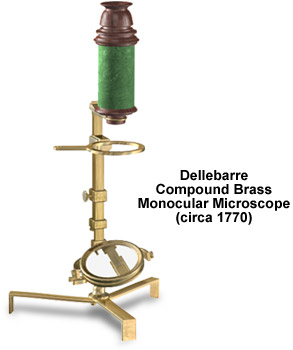Dellebarre Compound Monocular Microscope
Outfitted with mountings and accessories crafted of fine ivory, brass, and vellum, this unsigned microscope, estimated to be dated around 1770, is a rare find. The model featured below was redrawn from photographs of the original microscope, which is part of the Billings microscope collection at Walter Reed Army Hospital in Washington DC.

Although bearing no stamp, this microscope features the unmistakable trademark workmanship of Dutch manufacturer Louis F. Dellebarre, whose unique works are not known to be replicated by other makers. The base is comprised of a folding tripod that supports a rectangular brass pillar on a hinge joint with a screw clamp. A double mirror is attached to the base of the pillar by a fixed hinged arm that is fitted with a gimbal, which allows the device to fold upwards. The crown of the pillar supports a circular specimen stage and is equipped with an arm that extends forceps. A second pillar, located just behind the first, is fitted with a slide-in holder that is designed to accommodate the body of either a simple or compound microscope. Fine focus adjustment is accomplished by manipulating a screw located at the base of the second pillar, which raises or lowers the body tube. The combination microscope stands approximately 12 inches high and all mountings are carved from blackened ivory. The bi-convex lens is shielded by a screw cap.
Covered in green vellum, the 3-inch long compound body tube is beautifully crafted. The drawtube is also constructed of paper and adorned in green vellum. Finished in shark skin is an accessory box (not illustrated) that contains 4 objectives with ivory caps, 2 Lieberkuhn reflectors with ivory caps, 3 ivory sliders, ivory talc box, brass slide and tube holder, and a hollow ground slide in folding brass frame.
BACK TO EIGHTEENTH CENTURY MICROSCOPES
